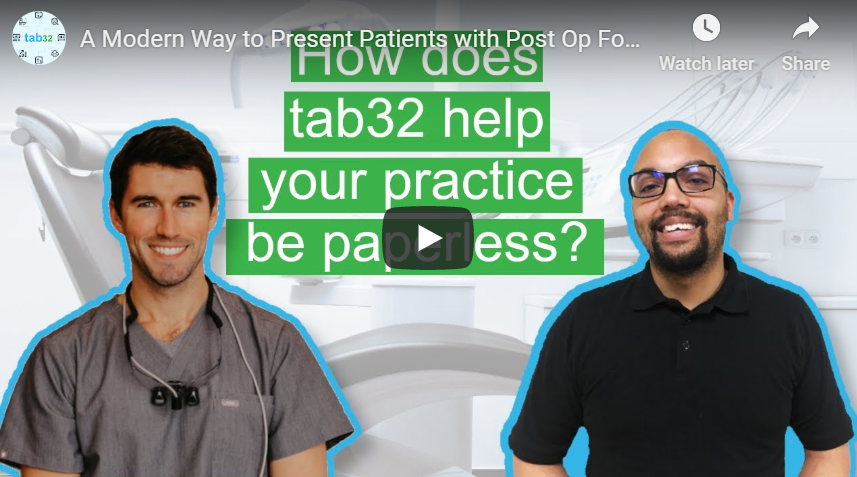While most dental practices focus on acquiring new patients, fewer pay attention to the patient experience after a treatment. Yet, since it’s more expensive to acquire a new patient than to retain one, it’s important not to overlook the patient experience throughout the entire care continuum.
Post-op care can make a big difference in how patients feel about your practice and patient outcomes. It’s a key component of collaborative, coordinated, and cohesive patient-centric care.
A great post-op experience encourages patients to return for a follow-up or re-care visit. They’ll also be more likely to tell others about your practice so you can leverage the power of word-of-mouth and referral to grow your business.
However, just sending patients home with a wad of gauze and a piece of paper with post-op instructions (in 9-point fonts!) is no longer enough if you want to deliver an outstanding patient experience so you can build long-term relationships and improve your retention rates.
Not to mention, paper handouts are easily lost or misplaced. The information is often dense and hard to read, so patients are less likely to follow the instructions. As consumers are going paperless, giving them pieces of paper would simply make your practice look “archaic” and impact your credibility.
Here’s how to improve your post-op experience and improve patient outcomes:
- Automate a series of post-op email sequences, each targeted to a specific procedure to ensure that patients are getting the most relevant information at the right time.
- Use a patient communication platform, such as tab32’s HelloPatient, that integrates with your EHR system and dental practice management platform to deliver a seamless patient experience.
- Create templates for your emails to deliver a consistent brand image and patient experience while improving cost-efficiency.
- Address FAQs and common complaints in your post-op communications to reduce the number of phone calls to your office.
- Post in-depth resources and how-to videos on your website, then include the links in the post-op emails so patients can access the information at their convenience when they need it.
- Explain the “why” behind the instructions to educate patients about the consequences of not following the steps (e.g., complications, more pain, delayed healing.) It helps encourage compliance and optimize patient outcomes.
- Guide patients through the recovery process by sending out the appropriate content at the right time. Set realistic expectations (e.g., the degree of pain) to alleviate anxiety while reducing calls to your office.
- Make your emails easy-to-read, break up the information into digestible chunks, and use language that can be easily understood by laypersons. You can also include downloadable checklists to encourage compliance.
- Include links to purchase the necessary products, equipment, or medication required for recovery in the emails. You can explore additional income potential by setting up an online store or using affiliate links.
- Make it easy for patients to get support and assistance by including your contact information in the post-op instructions. For example, by encouraging them to “just hit reply” with their questions (don’t send from a “no-reply” email address!)
- Use tracking and analytics to see how patients interact with your post-op instructions so you can improve the content and experience. You can also follow up with those that haven’t read the emails to make sure they’re recovering properly.
- Incorporate a follow-up reminder in your post-op email series and include a link for patients to schedule an appointment online to ensure they’re getting the appropriate care.
- Encourage patients to send photos or use video conferencing if they need assistance so they can get their questions answered without visiting your office. This can streamline their experience while improving your cost-efficiency.
- Train your staff on basic post-op care so they can provide immediate answers via phone, text, or chat. If you offer such on-demand care, use a patient communication platform that allows you to pull up patient records and manage patient communications all on one screen to minimize errors and inefficiencies.
- Don’t overwhelm patients with information right after the procedure! Simply tell them to go home, focus on healing, check their email for post-op instructions, and call your office with questions. This can create an empathetic experience that will improve patient satisfaction.
Conclusion
Post-op recovery is an important part of the patient experience. Providing your patients with the appropriate information and support in the right place and at the right time can help you optimize patient outcomes, improve patient satisfaction, and increase retention rates.
To improve the patient experience cost-efficiently, use a patient communication platform that integrates with the EHR system so you can automate targeted communication based on each patient’s treatment and history.
See how you can improve patient outcomes with effective post-op communications by using our patient-first, all-in-one dental practice management platform here.

No Comments Yet
Let us know what you think